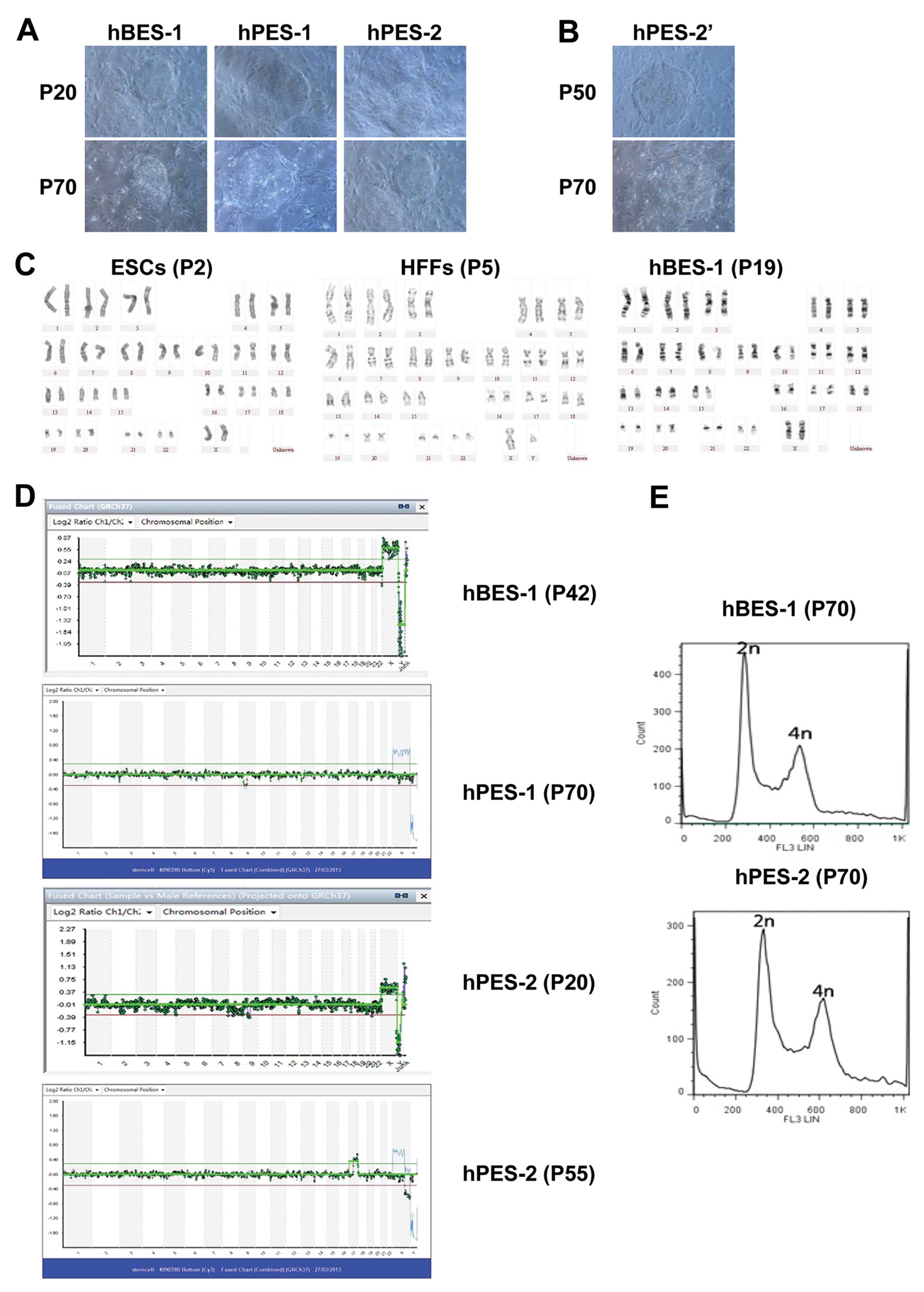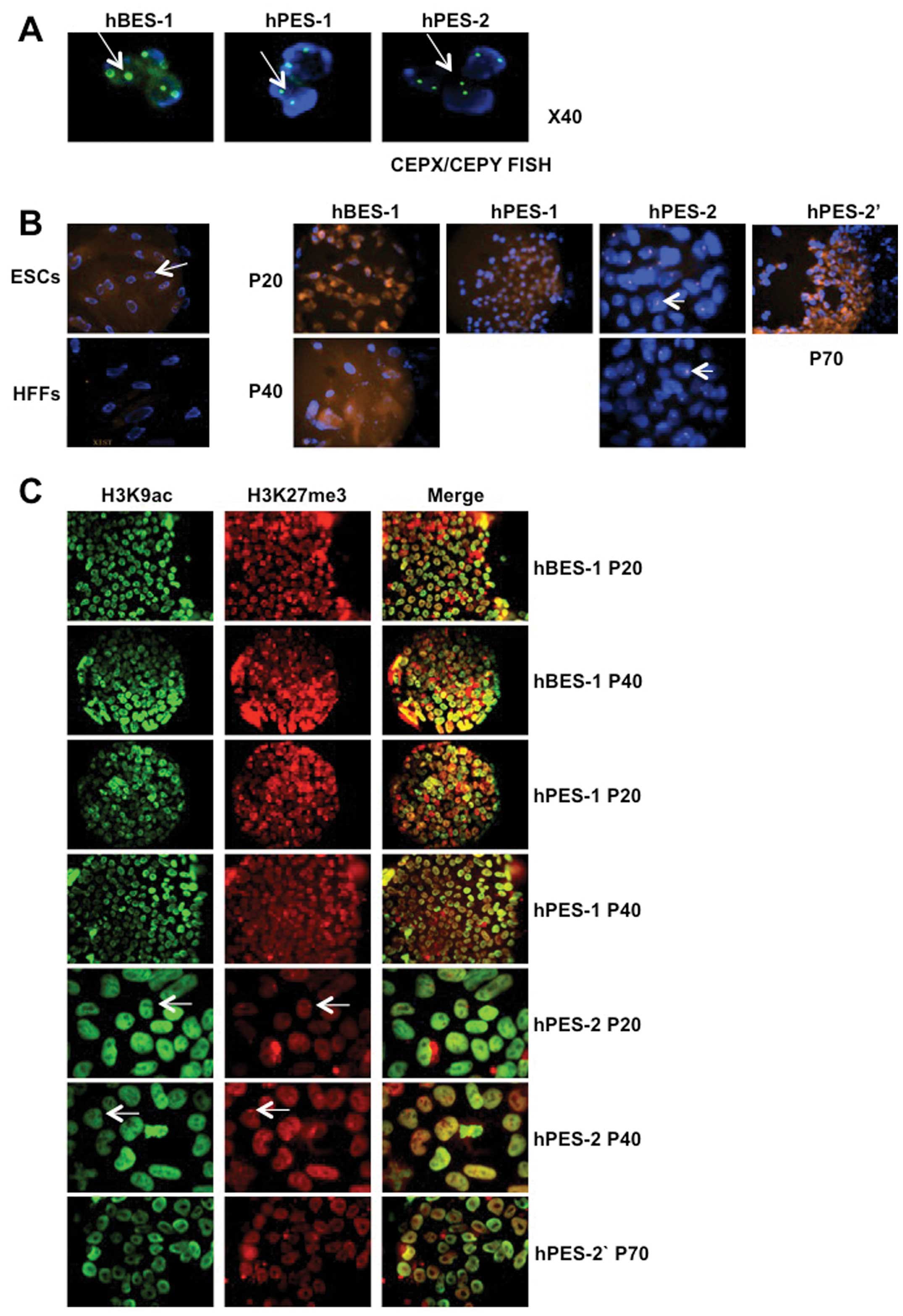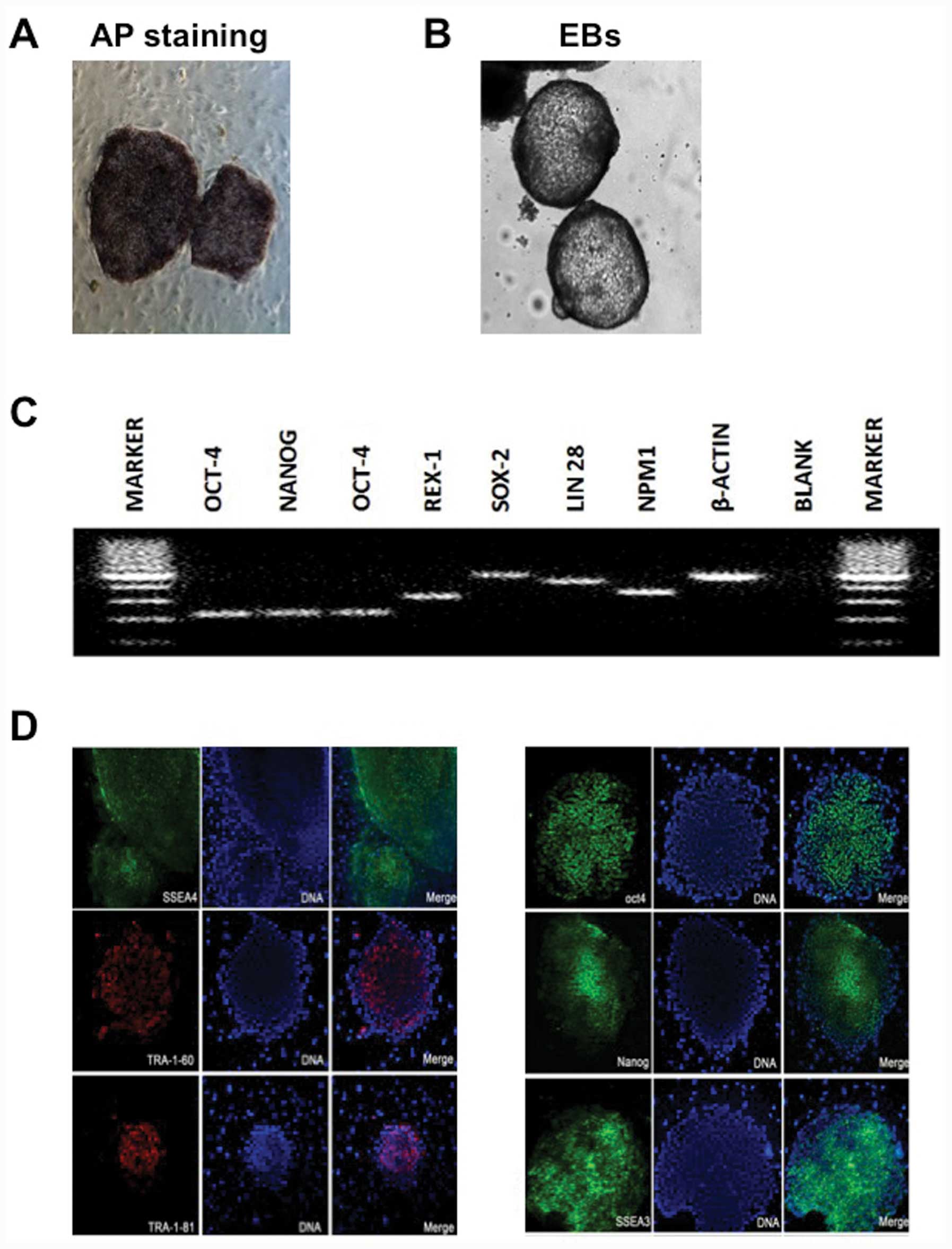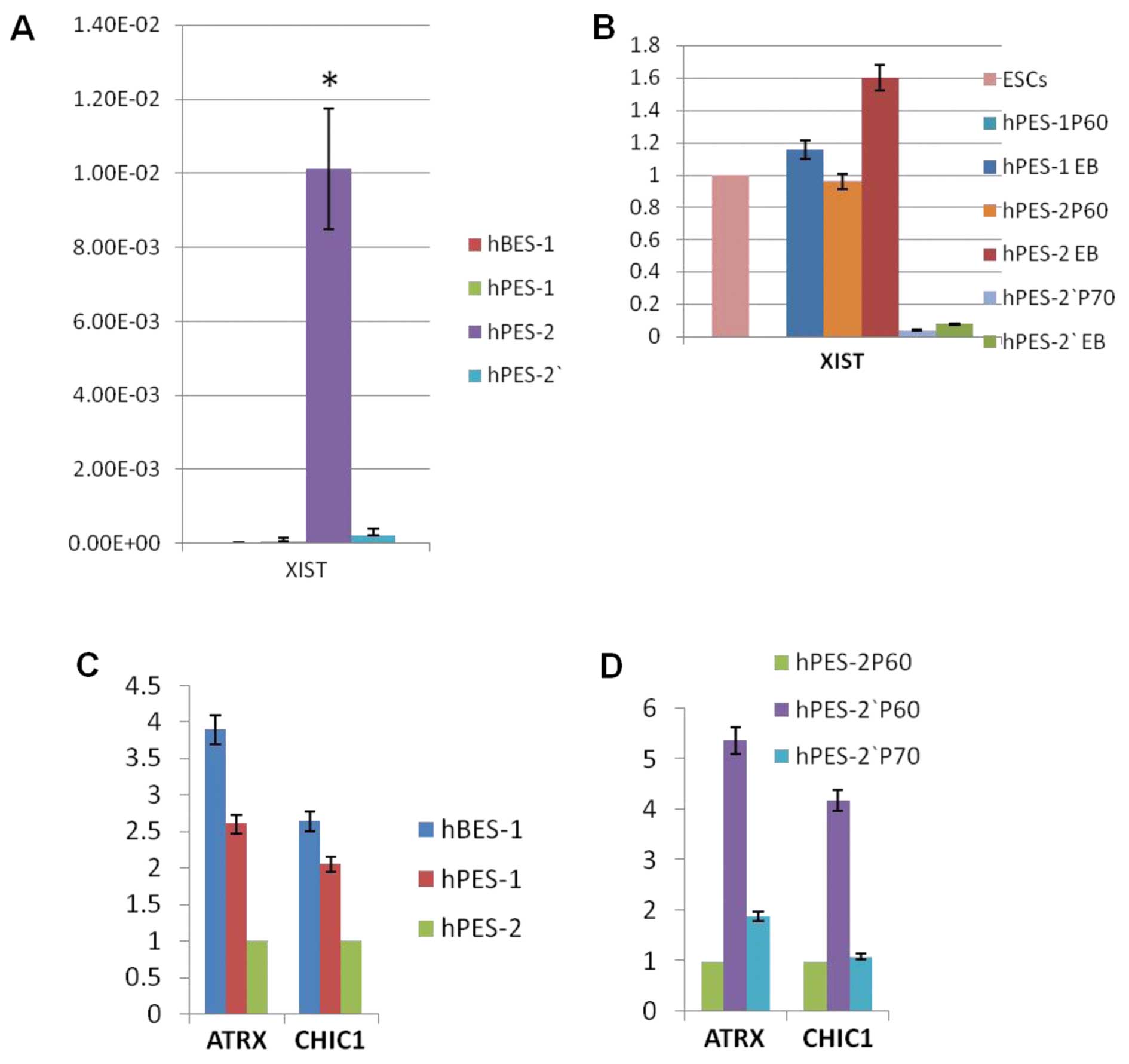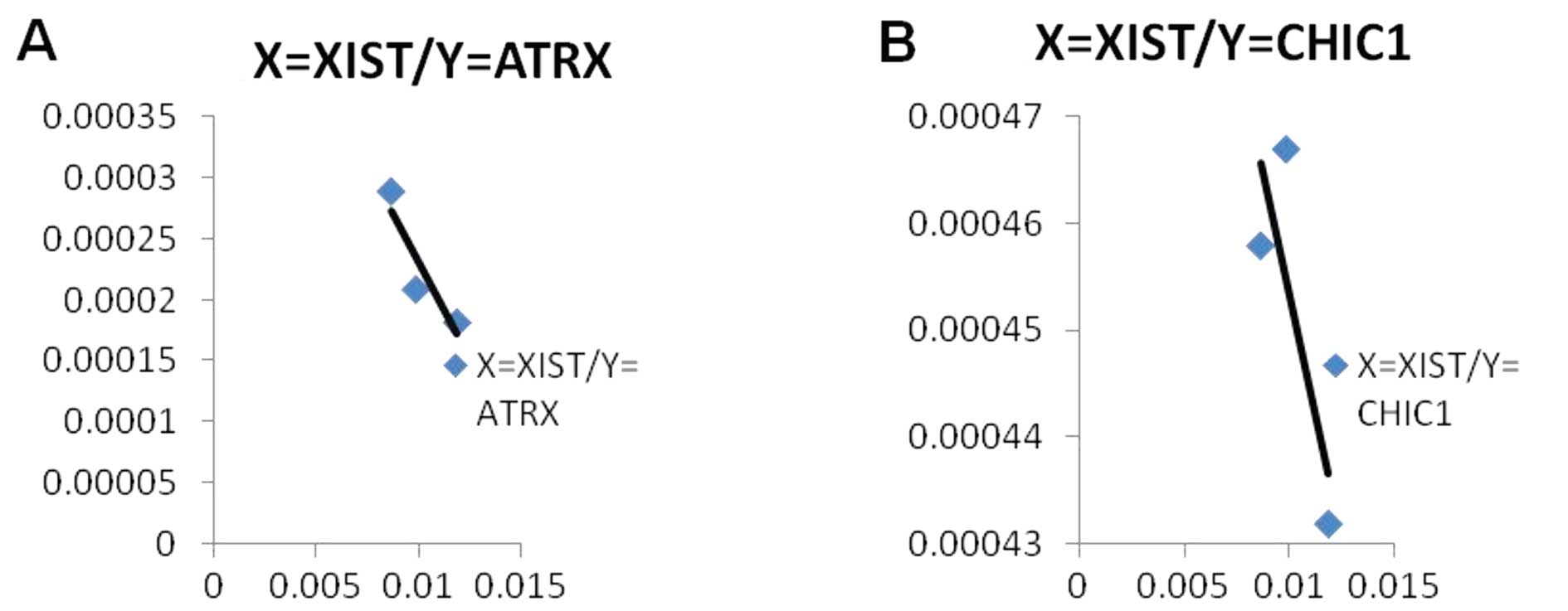|
1
|
Lindvall O and Kokaia Z: Stem cells for
the treatment of neurological disorders. Nature. 441:1094–1096.
2006. View Article : Google Scholar : PubMed/NCBI
|
|
2
|
Vats A, Bielby RC, Tolley NS, Nerem R and
Polak JM: Stem cells. Lancet. 366:592–602. 2005. View Article : Google Scholar : PubMed/NCBI
|
|
3
|
Szabó P and Mann JR: Expression and
methylation of imprinted genes during in vitro differentiation of
mouse parthenogenetic and androgenetic embryonic stem cell lines.
Development. 120:1651–1660. 1994.PubMed/NCBI
|
|
4
|
Lin G, OuYang Q, Zhou X, et al: A highly
homozygous and parthenogenetic human embryonic stem cell line
derived from a one-pronuclear oocyte following in vitro
fertilization procedure. Cell Res. 17:999–1007. 2007. View Article : Google Scholar : PubMed/NCBI
|
|
5
|
Revazova ES1, Turovets NA, Kochetkova OD,
Kindarova LB, Kuzmichev LN, Janus JD and Pryzhkova MV:
Patient-specific stem cell lines derived from human parthenogenetic
blastocysts. Cloning and Stem Cells. 9:432–449. 2007. View Article : Google Scholar : PubMed/NCBI
|
|
6
|
Mai Q, Yu Y, Li T, et al: Derivation of
human embryonic stem cell lines from parthenogenetic blastocysts.
Cell Res. 17:1008–1019. 2007. View Article : Google Scholar : PubMed/NCBI
|
|
7
|
Revazova ES, Turovets NA, Kochetkova OD,
et al: HLA homozygous stem cell lines derived from human
parthenogenetic blastocysts. Cloning Stem Cells. 10:11–24. 2008.
View Article : Google Scholar
|
|
8
|
Lu Z, Zhu W, Yu Y, et al: Derivation and
long-term culture of human parthenogenetic embryonic stem cells
using human foreskin feeders. J Assist Reprod Genet. 27:285–291.
2010. View Article : Google Scholar : PubMed/NCBI
|
|
9
|
Zhao Q, Wang J, Zhang Y, Kou Z, Liu S and
Gao S: Generation of histocompatible androgenetic embryonic stem
cells using spermatogenic cells. Stem Cells. 28:229–239. 2010.
|
|
10
|
Maitra A, Arking DE, Shivapurkar N, et al:
Genomic alterations in cultured human embryonic stem cells. Nat
Genet. 37:1099–1103. 2005. View
Article : Google Scholar : PubMed/NCBI
|
|
11
|
Silva SS, Rowntree RK, Mekhoubad S and Lee
JT: X-chromosome inactivation and epigenetic fluidity in human
embryonic stem cells. Proc Nat Acad Sci USA. 105:4820–4825. 2008.
View Article : Google Scholar : PubMed/NCBI
|
|
12
|
Allegrucci C, Thurston A, Lucas E and
Young L: Epigenetics and the germline. Reproduction. 129:137–149.
2005. View Article : Google Scholar : PubMed/NCBI
|
|
13
|
Allegrucci C, Denning C, Priddle H and
Young L: Stem-cell consequences of embryo epigenetic defects.
Lancet. 364:206–208. 2004. View Article : Google Scholar : PubMed/NCBI
|
|
14
|
Tomkins DJ, McDonald HL, Farrell SA and
Brown CJ: Lack of expression of XIST from a small ring X chromosome
containing the XIST locus in a girl with short stature, facial
dysmorphism and developmental delay. Eur J Hum Genet. 10:44–51.
2002. View Article : Google Scholar : PubMed/NCBI
|
|
15
|
Sugawara O, Takagi N and Sasaki M:
Correlation between X-chromosome inactivation and cell
differentiation in female preimplantation mouse embryos. Cytogenet
Cell Genet. 39:210–219. 1985. View Article : Google Scholar : PubMed/NCBI
|
|
16
|
Hall LL, Byron M, Butler J, et al:
X-inactivation reveals epigenetic anomalies in most hESC but
identifies sublines that initiate as expected. J Cell Physiol.
216:445–452. 2008. View Article : Google Scholar : PubMed/NCBI
|
|
17
|
Dhara SK and Benvenisty N: Gene trap as a
tool for genome annotation and analysis of X chromosome
inactivation in human embryonic stem cells. Nucleic Acids Res.
32:3995–4002. 2004. View Article : Google Scholar : PubMed/NCBI
|
|
18
|
Shen Y, Matsuno Y, Fouse SD, et al:
X-inactivation in female human embryonic stem cells is in a
nonrandom pattern and prone to epigenetic alterations. Proc Nat
Acad Sci USA. 105:4709–4714. 2008. View Article : Google Scholar : PubMed/NCBI
|
|
19
|
Lengner CJ, Gimelbrant AA, Erwin JA, et
al: Derivation of pre-X inactivation human embryonic stem cells
under physiological oxygen concentrations. Cell. 141:872–883. 2010.
View Article : Google Scholar : PubMed/NCBI
|
|
20
|
Li T, Zhou CQ, Mai QY and Zhuang GL:
Establishment of human embryonic stem cell line from gamete donors.
Chin Med J (Engl). 118:116–122. 2005.
|
|
21
|
Li T, Mai Q, Gao J and Zhou C:
Cryopreservation of human embryonic stem cells with a new bulk
vitrification method. Biol Reprod. 82:848–853. 2010. View Article : Google Scholar : PubMed/NCBI
|
|
22
|
Ryan IP, Schriock ED and Taylor RN:
Isolation, characterization, and comparison of human endometrial
and endometriosis cells in vitro. J Clin Endocrinol Metab.
78:642–649. 1994.PubMed/NCBI
|
|
23
|
Qin XY, Sone H, Kojima Y, et al:
Individual variation of the genetic response to bisphenol a in
human foreskin fibroblast cells derived from cryptorchidism and
hypospadias patients. PLoS One. 7:e527562012. View Article : Google Scholar
|
|
24
|
Fiorentino F1, Spizzichino L, Bono S, et
al: PGD for reciprocal and Robertsonian translocations using array
comparative genomic hybridization. Hum Reprod. 26:1925–1935. 2011.
View Article : Google Scholar : PubMed/NCBI
|
|
25
|
Brockdorff N, Ashworth A, Kay GF, et al:
Conservation of position and exclusive expression of mouse Xist
from the inactive X chromosome. Nature. 351:329–331. 1991.
View Article : Google Scholar : PubMed/NCBI
|
|
26
|
Brown CJ, Ballabio A, Rupert JL,
Lafreniere RG, Grompe M, Tonlorenzi R and Willard HF: A gene from
the region of the human X inactivation centre is expressed
exclusively from the inactive X chromosome. Nature. 349:38–44.
1991. View
Article : Google Scholar : PubMed/NCBI
|
|
27
|
Penny GD, Kay GF, Sheardown SA, Rastan S
and Brockdorff N: Requirement for Xist in X chromosome
inactivation. Nature. 379:131–137. 1996. View Article : Google Scholar : PubMed/NCBI
|
|
28
|
Heard E and Disteche CM: Dosage
compensation in mammals: fine-tuning the expression of the X
chromosome. Genes Dev. 20:1848–1867. 2006. View Article : Google Scholar : PubMed/NCBI
|
|
29
|
Okamoto I, Otte AP, Allis CD, Reinberg D
and Heard E: Epigenetic dynamics of imprinted X inactivation during
early mouse development. Science. 303:644–649. 2004. View Article : Google Scholar
|
|
30
|
Costanzi C and Pehrson JR: Histone
macroH2A1 is concentrated in the inactive X chromosome of female
mammals. Nature. 393:599–601. 1998. View
Article : Google Scholar : PubMed/NCBI
|
|
31
|
Chadwick BP and Willard HF: Cell
cycle-dependent localization of macroH2A in chromatin of the
inactive X chromosome. J Cell Biol. 157:1113–1123. 2002. View Article : Google Scholar : PubMed/NCBI
|
|
32
|
Navarro P, Chambers I, Karwacki-Neisius V,
Chureau C, Morey C, Rougeulle C and Avner P: Molecular coupling of
Xist regulation and pluripotency. Science. 321:1693–1695. 2008.
View Article : Google Scholar : PubMed/NCBI
|
|
33
|
Kim K, Lerou P, Yabuuchi A, et al:
Histocompatible embryonic stem cells by parthenogenesis. Science.
315:482–486. 2007. View Article : Google Scholar
|
|
34
|
Taylor CJ, Bolton EM, Pocock S, Sharples
LD, Pedersen RA and Bradley JA: Banking on human embryonic stem
cells: estimating the number of donor cell lines needed for HLA
matching. Lancet. 366:2019–2025. 2005. View Article : Google Scholar : PubMed/NCBI
|
|
35
|
Jiang H, Sun B, Wang W, et al: Activation
of paternally expressed imprinted genes in newly derived
germline-competent mouse parthenogenetic embryonic stem cell lines.
Cell Res. 17:792–803. 2007. View Article : Google Scholar : PubMed/NCBI
|
|
36
|
Liu W, Yin Y, Jiang Y, et al: Genetic and
epigenetic X-chromosome variations in a parthenogenetic human
embryonic stem cell line. J Assist Reprod Genet. 28:303–313. 2011.
View Article : Google Scholar :
|
|
37
|
Allegrucci C and Young LE: Differences
between human embryonic stem cell lines. Hum Reprod Update.
13:103–120. 2007. View Article : Google Scholar
|
|
38
|
Liu W, Guo L, He W, Li Q and Sun X: Higher
copy number variation and diverse X chromosome inactivation in
parthenote-derived human embryonic stem cells. J Reprod Dev.
58:642–648. 2012. View Article : Google Scholar : PubMed/NCBI
|
|
39
|
Ganesan S, Richardson AL, Wang ZC, et al:
Abnormalities of the inactive X chromosome are a common feature of
BRCA1 mutant and sporadic basal-like breast cancer. Cold Spring
Harb Symp Quant Biol. 70:93–97. 2005. View Article : Google Scholar
|



